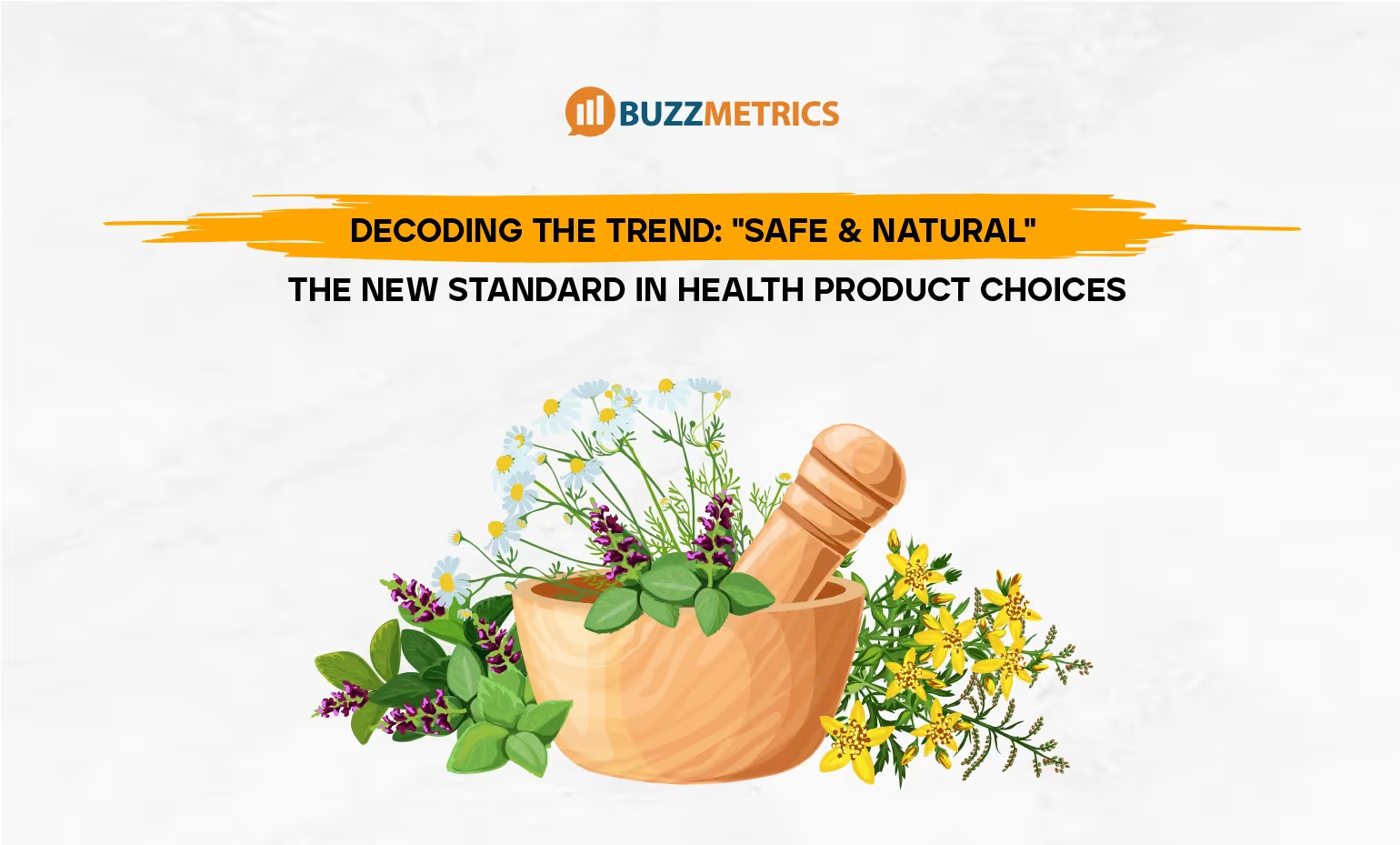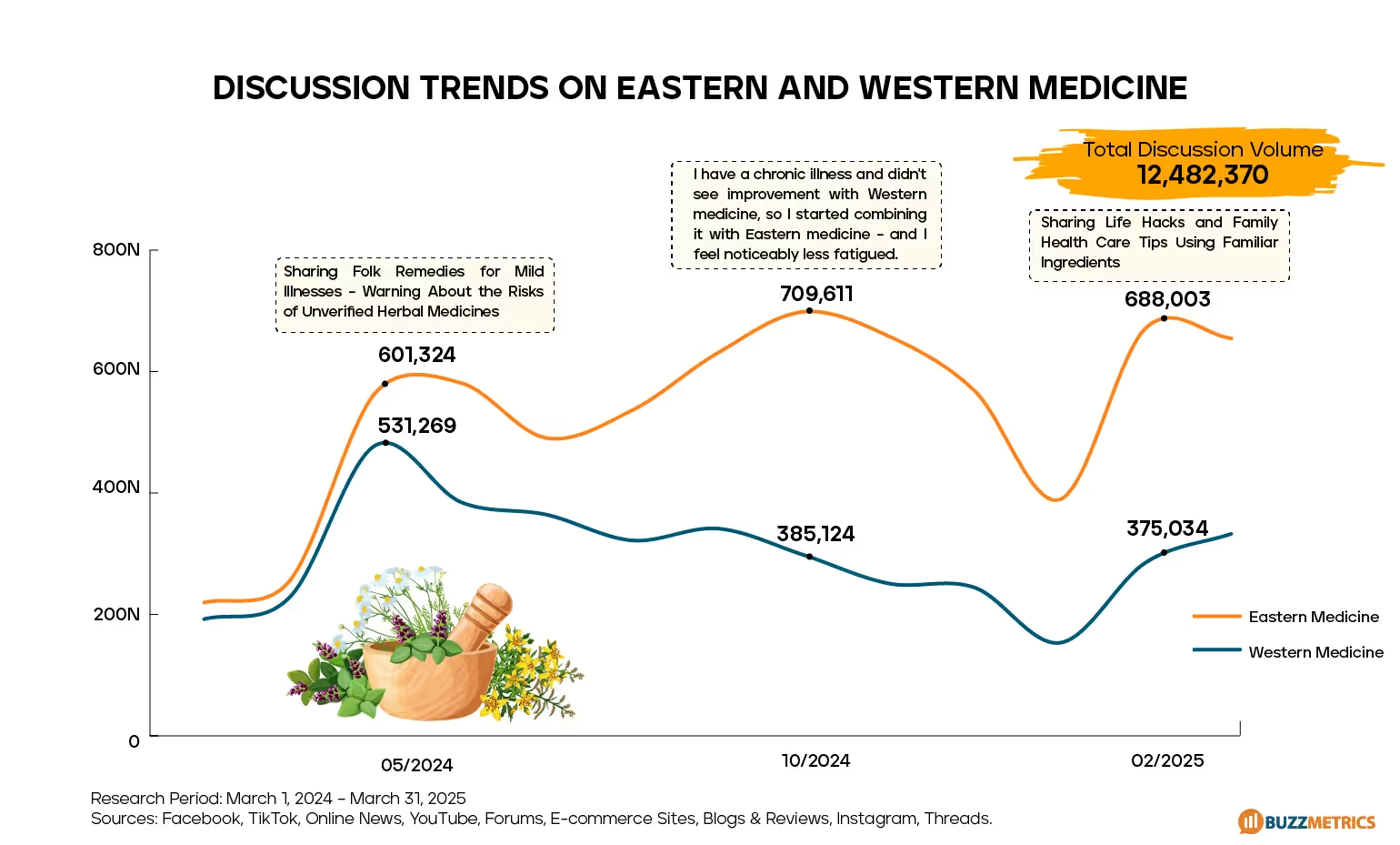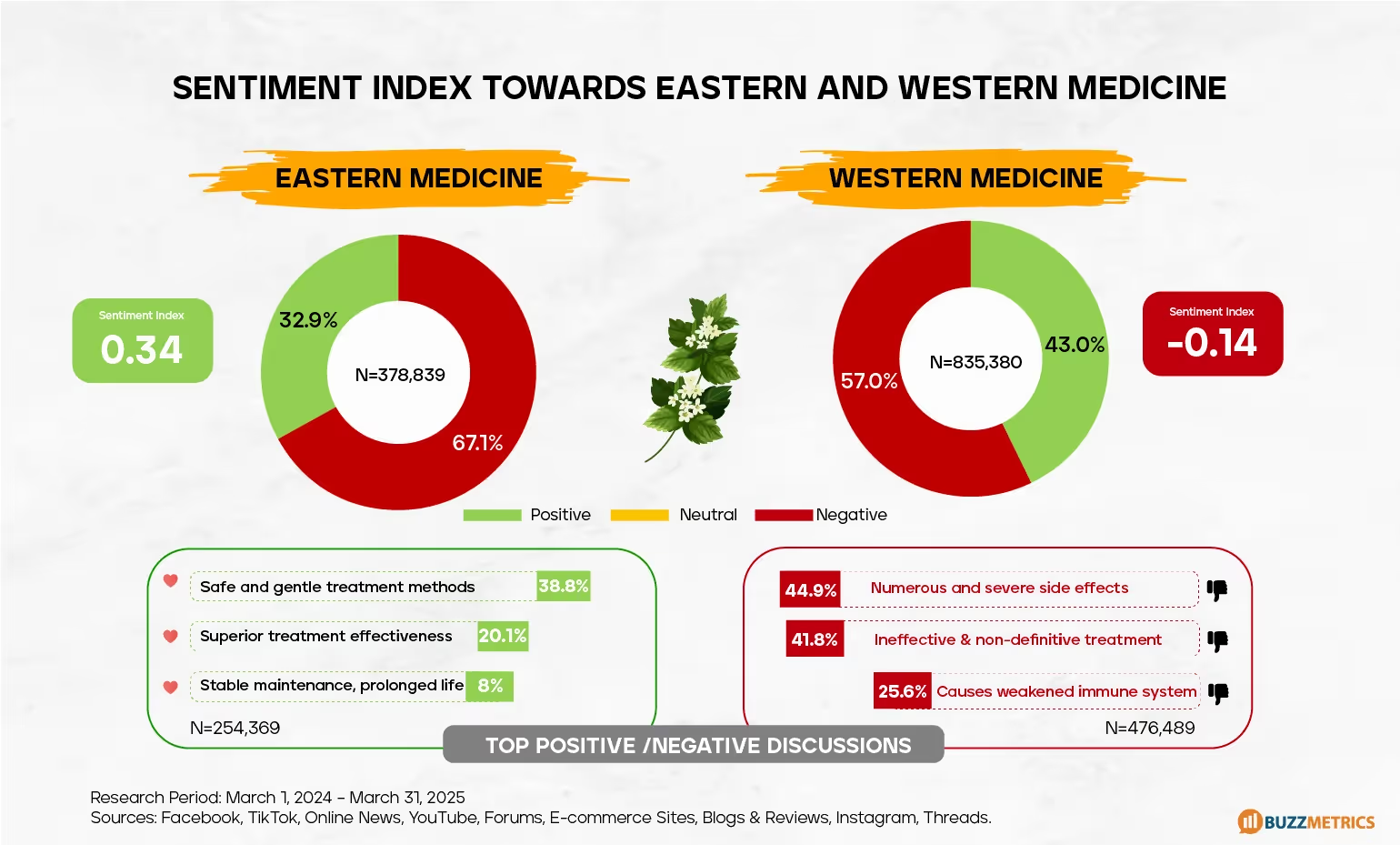Safe & Natural: A New Standard Shaping Health Product Choices

Buzzmetrics analysis shows that when choosing treatment products, consumers no longer prioritize price or instant effectiveness. Instead, they value safety and natural origin - a new definition of “effective treatment.” This article decodes this trend and the opportunities it brings for brands.
From discussion trends and consumer insights in the Pharmaceutical industry, the preference for safe and natural products has been validated and widely spread, influencing both purchasing behavior and the healthcare market. Let’s join Buzzmetrics in decoding this trend through the lens of social media conversation analysis, to uncover meaningful consumer insights.
1. FROM A PHARMACEUTICAL PERSPECTIVE – THE RISE IN EASTERN MEDICINE AS A TREATMENT CHOICE
In the process of analyzing consumer behavior in the healthcare category, Buzzmetrics identified a clear shift, particularly reflected in discussions related to the pharmaceutical category. Specifically, when it comes to treatment methods involving medication, social media users make a clear distinction between Eastern and Western Medicine. Based on over a year of discussion data from March 2024 to February 2025, their usage behavior and areas of interest have shown significant differentiation and change.
1.1. Discussions on Eastern Medicine are rising, with a growing share compared to Western Medicine
In early 2024, discussions around both Eastern and Western Medicine hovered at approximately 200,000 mentions per month. After one year, the total discussion volume surged, reaching 1,063,037 mentions by February 2025 - reflecting significantly higher interest from social media users compared to the same period last year. A closer look at the trendlines reveals notable fluctuations in the gap between discussions on Eastern and Western Medicine.
- Discussions on Eastern Medicine grew steadily during the research period, peaking at 709,611 mentions in October 2024. Throughout the year, monthly discussions consistently remained above 300,000.
- While discussions on Western Medicine also experienced a period of steady growth, they peaked at 531,269 mentions in May 2024, followed by a consistent downward trend toward early 2025.
Overall, the trend shows that discussions on Eastern Medicine accounted for a significantly larger share, consistently surpassing those on Western Medicine. At certain points, the gap reached nearly double.

Given the significant differences in discussion volume, why is Eastern Medicine being mentioned more frequently by users than Western Medicine?
1.2. The intersection of Eastern and Western Medicine in discussions on treating non-serious illnesses
In terms of severity, illnesses are divided into two groups: serious and non-serious. For serious illnesses, treatment decisions largely depend on medical indications and doctors' expertise. Therefore, this report focuses on non-serious illnesses - where users tend to take a more proactive role, with over 1.8 million people participating in related discussions.
.avif)
Within this group, illnesses are further divided based on user behavior and treatment preferences. For acute symptoms that require immediate attention such as fever (105,064 mentions) or headache/ dizziness (133,572 mentions), users tend to favor Western Medicine for its fast-acting effects and ability to quickly manage the situation. In contrast, for more prolonged symptoms like insomnia, fatigue or sore throat, Eastern Medicine is preferred due to the perception of being “safe - non-exhausting - long-term use without side effects”.
- Acute conditions (fever, headache): Users tend to prefer Western Medicine for its rapid action and ability to provide immediate symptom relief.
- Prolonged conditions (insomnia, fatigue, sore throat): Users lean toward Eastern Medicine due to its mild nature and long-term use without concern for side effects.
In addition, several common symptoms such as stomachache, flu and nasal congestion are discussed in relation to both treatment approaches - highlighting the intersection between Eastern and Western Medicine.
Users choose Eastern Medicine not only for its effectiveness, but also for its perceived qualities: safety, natural ingredients, and minimal long-term health impact. This reveals a key insight: Eastern Medicine is seen as a sustainable approach to healthcare, rather than a quick-fix treatment.
Notably, acute conditions remain the “domain” of Western Medicine. However, based on emerging trends and the expectation factors previously analyzed, Eastern Medicine brands can tap into the potential of treating acute conditions with recurring and lingering symptoms, leveraging their perceived advantages of being safe, gentle and targeting the root cause of the illness.
1.3. Reasons why users choose Eastern Medicine: From long-lasting effectiveness to trust in its gentleness

Beyond treatment effectiveness, users primarily choose Eastern Medicine based on two key factors: safety - gentleness and natural origin. Specifically:
- Treatment Effectiveness (25,1%)
Users value the “gradual but sustainable” effectiveness of Eastern Medicine - which helps improve health conditions without causing fatigue or putting stress on the body. This type of effectiveness is well-suited for non-acute symptoms that have long-term impacts on quality of life. - Safety - Gentleness (16,4%)
Eastern Medicine is favored for its suitability for long-term use and for being safe for the whole family. User discussions frequently mention descriptions like “doesn’t harm the liver or kidneys”, “doesn’t cause fatigue” and “can be used regularly without worrying about side effects”. - Natural Origin – Familiarity – Trust (14,9%)
Herbal ingredients such as lemon, ginger, honey and licorice create a sense of trust due to their familiarity. This trust is further reinforced by traditional knowledge and real-life experiences passed down through generations within families.
For the same group of conditions, users express concerns about two key issues when using Western Medicine:
- Drug resistance and reduced effectiveness after prolonged use.
- Unwanted side effects, especially those affecting the liver, kidneys or digestive system.
These factors drive more careful consideration, particularly for recurring or long-lasting issues.
Although Eastern Medicine is viewed positively, users still hold clear expectations for its products: maintain gentleness, enhance convenience and elevate trust standards.
- Safe, natural ingredients - suitable for both serious and non-serious conditions.
- Ability to treat the root cause and support recovery after the effects of Western medication.
- User-friendly formats, easy to take, easy to trust and free from the inconveniences of traditional remedies
Ultimately, users are not only seeking gentle solutions, but also expecting modern Eastern Medicine to elevate the overall experience: combining traditional values with the convenience -reliability of modern healthcare.
1.4. User emotions reinforce the trend of prioritizing safety and naturalness
From an emotional sentiment perspective, the core difference between Eastern and Western Medicine is not only in treatment capability, but also in the user’s emotional experience.
- For Eastern Medicine: Discussions are predominantly positive (67.1%), associated with keywords like “comfortable”, “no fatigue”, “peace of mind”, “healing from within” and “no concern about side effects”.
- For Western Medicine: Emotions are influenced by concerns over negative experiences, with frequent mentions of phrases like “harmful to the liver and kidneys”, “drug resistance”, “internal heat” and long-term side effects.
Clearly, users do not deny the role of Western Medicine in urgent situations. However, they are increasingly unwilling to “trade off” long-term health for immediate effectiveness. The feeling of safety has become an equally important factor and even more positively perceived (38.8% of discussions) than treatment effectiveness itself (20.1% of discussions).

2. RIPPLE EFFECTS: FROM THE PHARMACEUTICAL INDUSTRY TO RELATED INDUSTRIES
The consumer trend of prioritizing safe, gentle and naturally sourced products is no longer limited to the Pharmaceutical industry, it is now expanding across various industries related to healthcare and everyday well-being.
According to Euromonitor (2023), the natural haircare market in Vietnam has reached a value of nearly USD 1 billion - clearly reflecting the growing demand for beauty solutions that emphasize long-term care and safety.
The factor of being “safe for the whole family” - from children to the elderly - is becoming a baseline standard when consumers choose personal care products.
One notable example is Nguyen Xuan - a herbal-based shampoo brand - which has made a breakthrough thanks to its clear positioning strategy and alignment with user insights.
2.1. A consistent communication strategy: “Gentle and Safe”
Nguyen Xuan has succeeded by telling a consistent brand story that directly addresses the key consumer expectations analyzed in Section 2:
- Emphasizing safety: “Gentle”, “safe for pregnant women”, “free from harsh chemicals”.
- Using familiar ingredients: Ginger, pomelo peel and basil - well-known herbal remedies that are easy to recognize and trust.
- Focusing on user experience: “Mild and soothing”, “safe for daily use without causing dryness”.
These messages are consistently echoed and affirmed by users in real conversations, creating a strong trust loop.
2.2. From the right Insight to E-commerce success

Buzzmetrics data confirms that this strategy has delivered tangible business results:
- Leading the share of voice: Nguyen Xuan accounted for nearly 50% share of voice in the overall shampoo category (45,203 out of 91,000 mentions).
- Driving purchase intent: 1,726 mentions indicated consideration to buy, reflecting strong consumer trust.
- Winning on e-commerce platforms: Ranked #1 in the shampoo category on major e-commerce platforms in 2024, with a GMV exceeding VND 200 billion.
Nguyen Xuan’s success is a clear testament to the power of capturing the right user insight and transforming it into a consistent communication and product strategy.
By combining emotional cues such as “safety” and “gentleness” with strong, action-oriented messaging, the brand not only earned consumer trust but also converted it into tangible business results.
CONCLUSION
The shift in consumer behavior - from prioritizing quick effectiveness to valuing safety, gentleness and natural origin - is reshaping not only the Pharmaceutical industry but also influencing other industries like healthcare and beauty. Positive emotional experiences and the sense of “peace of mind when using” are emerging as new competitive drivers, offering long-term advantages to brands that truly understand and meet evolving consumer expectations.
Article Information












_11zon.webp)
.webp)



_11zon.avif)





